Supply Chain Management: Gateway and Apple Retail Comparison
VerifiedAdded on 2022/04/18
|9
|2808
|114
Report
AI Summary
This report provides a comparative analysis of the retail strategies employed by Apple and Gateway, focusing on their supply chain management and inventory practices. The report begins with executive summaries of both companies, highlighting their backgrounds and key business decisions. It then delves into the contrasting approaches taken by each company regarding retail store inventory, make-to-order versus finished goods inventory, and the impact of product variety on inventory levels. The analysis explores why Gateway chose not to carry finished-product inventory while Apple did, and the characteristics of products best suited for each approach. The report also examines the cost-effectiveness of direct selling versus retail store supply chains and concludes with a discussion of the factors contributing to the success and failures of each company's retail strategy. The assignment is a BBA 6th semester submission, offering insights into supply chain management principles.
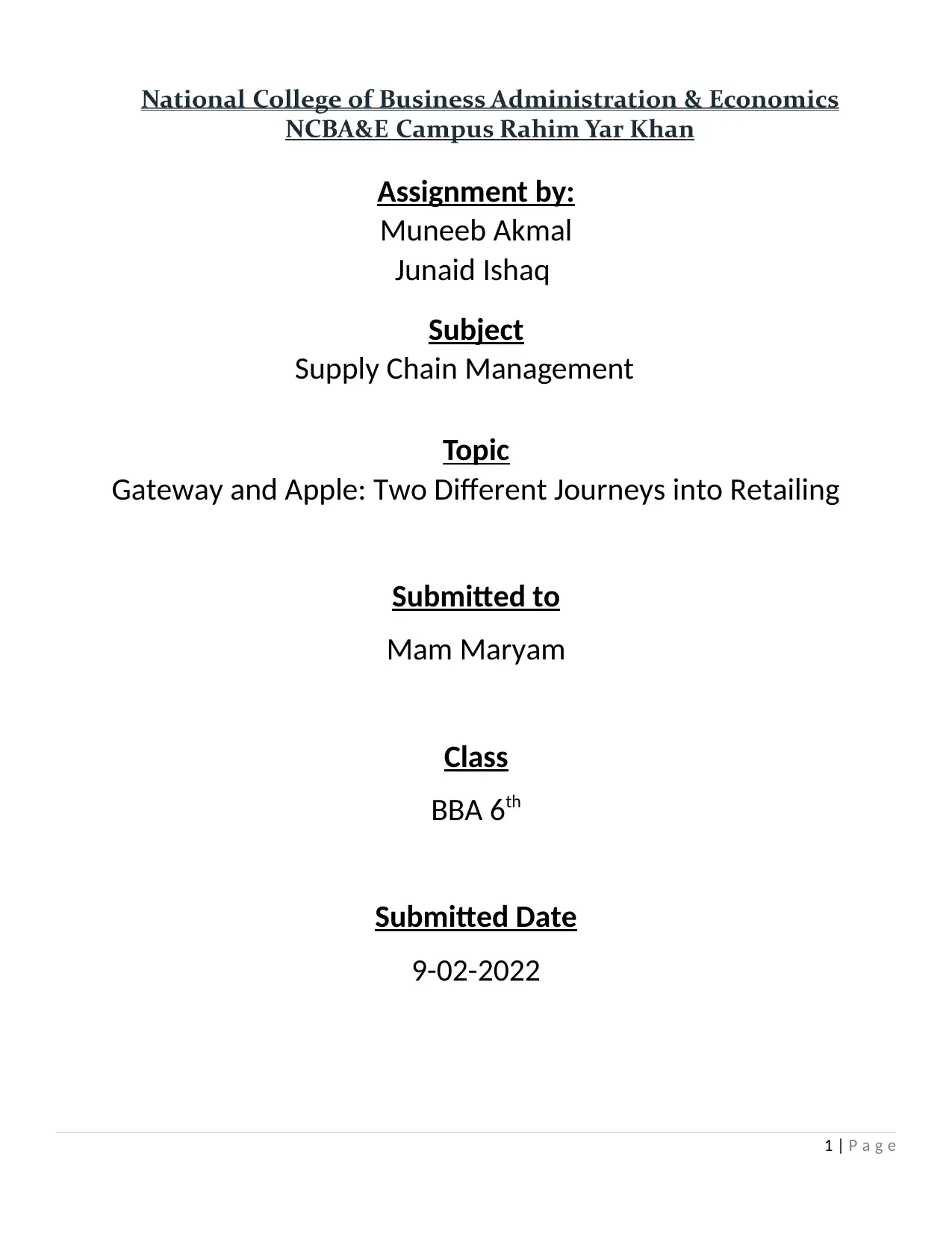
Assignment by:
Muneeb Akmal
Junaid Ishaq
Subject
Supply Chain Management
Topic
Gateway and Apple: Two Different Journeys into Retailing
Submitted to
Mam Maryam
Class
BBA 6th
Submitted Date
9-02-2022
1 | P a g e
Muneeb Akmal
Junaid Ishaq
Subject
Supply Chain Management
Topic
Gateway and Apple: Two Different Journeys into Retailing
Submitted to
Mam Maryam
Class
BBA 6th
Submitted Date
9-02-2022
1 | P a g e
Paraphrase This Document
Need a fresh take? Get an instant paraphrase of this document with our AI Paraphraser
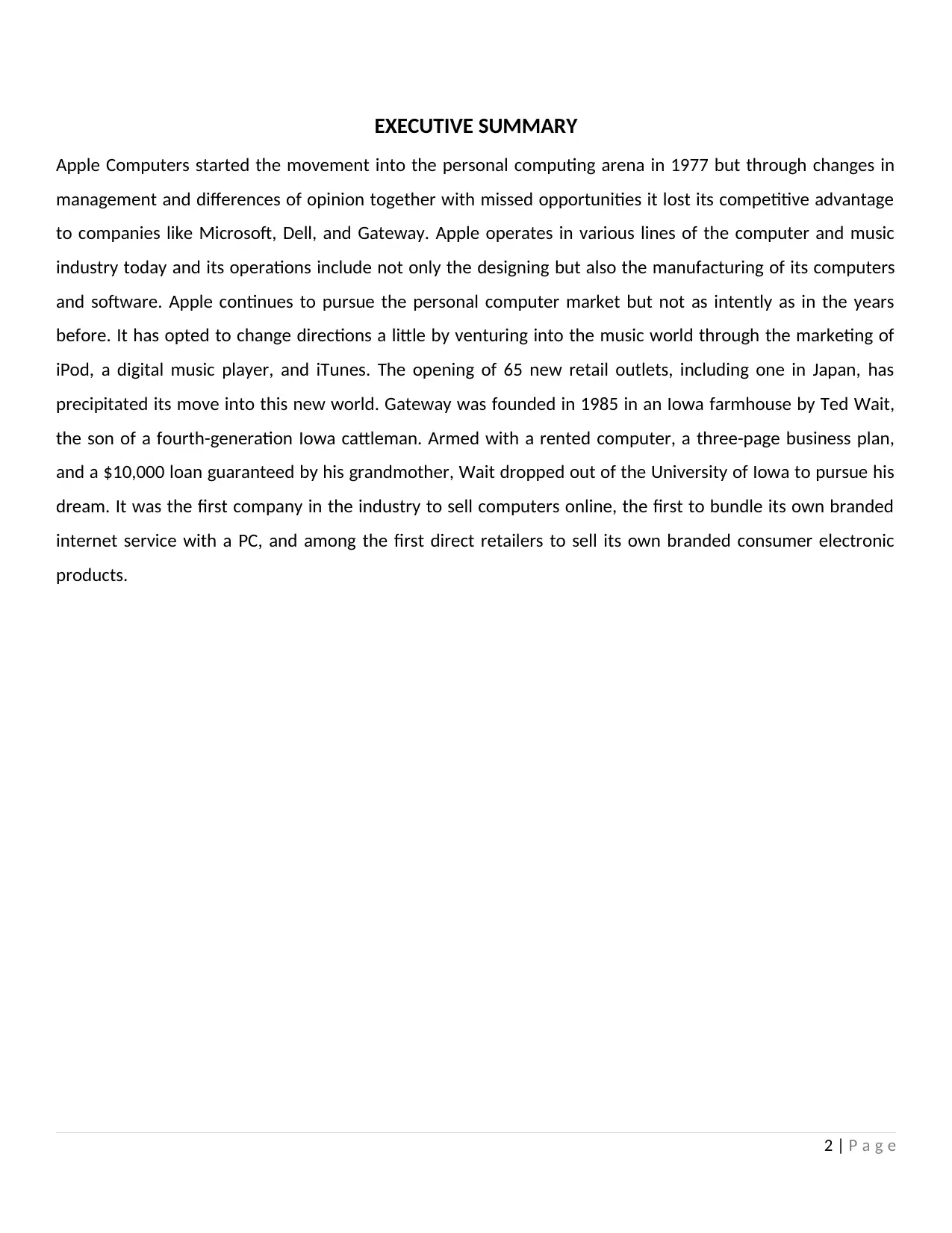
EXECUTIVE SUMMARY
Apple Computers started the movement into the personal computing arena in 1977 but through changes in
management and differences of opinion together with missed opportunities it lost its competitive advantage
to companies like Microsoft, Dell, and Gateway. Apple operates in various lines of the computer and music
industry today and its operations include not only the designing but also the manufacturing of its computers
and software. Apple continues to pursue the personal computer market but not as intently as in the years
before. It has opted to change directions a little by venturing into the music world through the marketing of
iPod, a digital music player, and iTunes. The opening of 65 new retail outlets, including one in Japan, has
precipitated its move into this new world. Gateway was founded in 1985 in an Iowa farmhouse by Ted Wait,
the son of a fourth-generation Iowa cattleman. Armed with a rented computer, a three-page business plan,
and a $10,000 loan guaranteed by his grandmother, Wait dropped out of the University of Iowa to pursue his
dream. It was the first company in the industry to sell computers online, the first to bundle its own branded
internet service with a PC, and among the first direct retailers to sell its own branded consumer electronic
products.
2 | P a g e
Apple Computers started the movement into the personal computing arena in 1977 but through changes in
management and differences of opinion together with missed opportunities it lost its competitive advantage
to companies like Microsoft, Dell, and Gateway. Apple operates in various lines of the computer and music
industry today and its operations include not only the designing but also the manufacturing of its computers
and software. Apple continues to pursue the personal computer market but not as intently as in the years
before. It has opted to change directions a little by venturing into the music world through the marketing of
iPod, a digital music player, and iTunes. The opening of 65 new retail outlets, including one in Japan, has
precipitated its move into this new world. Gateway was founded in 1985 in an Iowa farmhouse by Ted Wait,
the son of a fourth-generation Iowa cattleman. Armed with a rented computer, a three-page business plan,
and a $10,000 loan guaranteed by his grandmother, Wait dropped out of the University of Iowa to pursue his
dream. It was the first company in the industry to sell computers online, the first to bundle its own branded
internet service with a PC, and among the first direct retailers to sell its own branded consumer electronic
products.
2 | P a g e
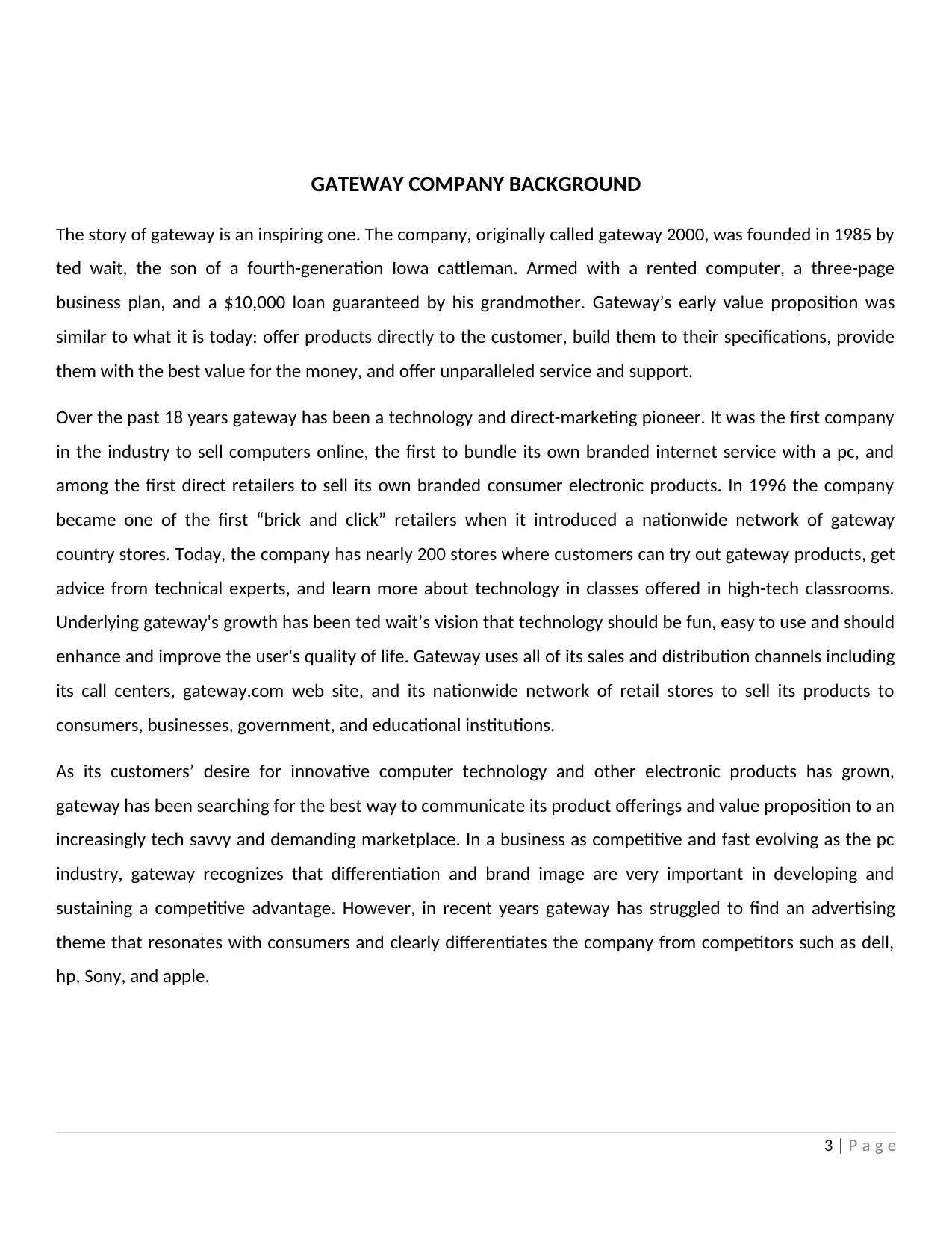
GATEWAY COMPANY BACKGROUND
The story of gateway is an inspiring one. The company, originally called gateway 2000, was founded in 1985 by
ted wait, the son of a fourth-generation Iowa cattleman. Armed with a rented computer, a three-page
business plan, and a $10,000 loan guaranteed by his grandmother. Gateway’s early value proposition was
similar to what it is today: offer products directly to the customer, build them to their specifications, provide
them with the best value for the money, and offer unparalleled service and support.
Over the past 18 years gateway has been a technology and direct-marketing pioneer. It was the first company
in the industry to sell computers online, the first to bundle its own branded internet service with a pc, and
among the first direct retailers to sell its own branded consumer electronic products. In 1996 the company
became one of the first “brick and click” retailers when it introduced a nationwide network of gateway
country stores. Today, the company has nearly 200 stores where customers can try out gateway products, get
advice from technical experts, and learn more about technology in classes offered in high-tech classrooms.
Underlying gateway's growth has been ted wait’s vision that technology should be fun, easy to use and should
enhance and improve the user's quality of life. Gateway uses all of its sales and distribution channels including
its call centers, gateway.com web site, and its nationwide network of retail stores to sell its products to
consumers, businesses, government, and educational institutions.
As its customers’ desire for innovative computer technology and other electronic products has grown,
gateway has been searching for the best way to communicate its product offerings and value proposition to an
increasingly tech savvy and demanding marketplace. In a business as competitive and fast evolving as the pc
industry, gateway recognizes that differentiation and brand image are very important in developing and
sustaining a competitive advantage. However, in recent years gateway has struggled to find an advertising
theme that resonates with consumers and clearly differentiates the company from competitors such as dell,
hp, Sony, and apple.
3 | P a g e
The story of gateway is an inspiring one. The company, originally called gateway 2000, was founded in 1985 by
ted wait, the son of a fourth-generation Iowa cattleman. Armed with a rented computer, a three-page
business plan, and a $10,000 loan guaranteed by his grandmother. Gateway’s early value proposition was
similar to what it is today: offer products directly to the customer, build them to their specifications, provide
them with the best value for the money, and offer unparalleled service and support.
Over the past 18 years gateway has been a technology and direct-marketing pioneer. It was the first company
in the industry to sell computers online, the first to bundle its own branded internet service with a pc, and
among the first direct retailers to sell its own branded consumer electronic products. In 1996 the company
became one of the first “brick and click” retailers when it introduced a nationwide network of gateway
country stores. Today, the company has nearly 200 stores where customers can try out gateway products, get
advice from technical experts, and learn more about technology in classes offered in high-tech classrooms.
Underlying gateway's growth has been ted wait’s vision that technology should be fun, easy to use and should
enhance and improve the user's quality of life. Gateway uses all of its sales and distribution channels including
its call centers, gateway.com web site, and its nationwide network of retail stores to sell its products to
consumers, businesses, government, and educational institutions.
As its customers’ desire for innovative computer technology and other electronic products has grown,
gateway has been searching for the best way to communicate its product offerings and value proposition to an
increasingly tech savvy and demanding marketplace. In a business as competitive and fast evolving as the pc
industry, gateway recognizes that differentiation and brand image are very important in developing and
sustaining a competitive advantage. However, in recent years gateway has struggled to find an advertising
theme that resonates with consumers and clearly differentiates the company from competitors such as dell,
hp, Sony, and apple.
3 | P a g e
⊘ This is a preview!⊘
Do you want full access?
Subscribe today to unlock all pages.

Trusted by 1+ million students worldwide
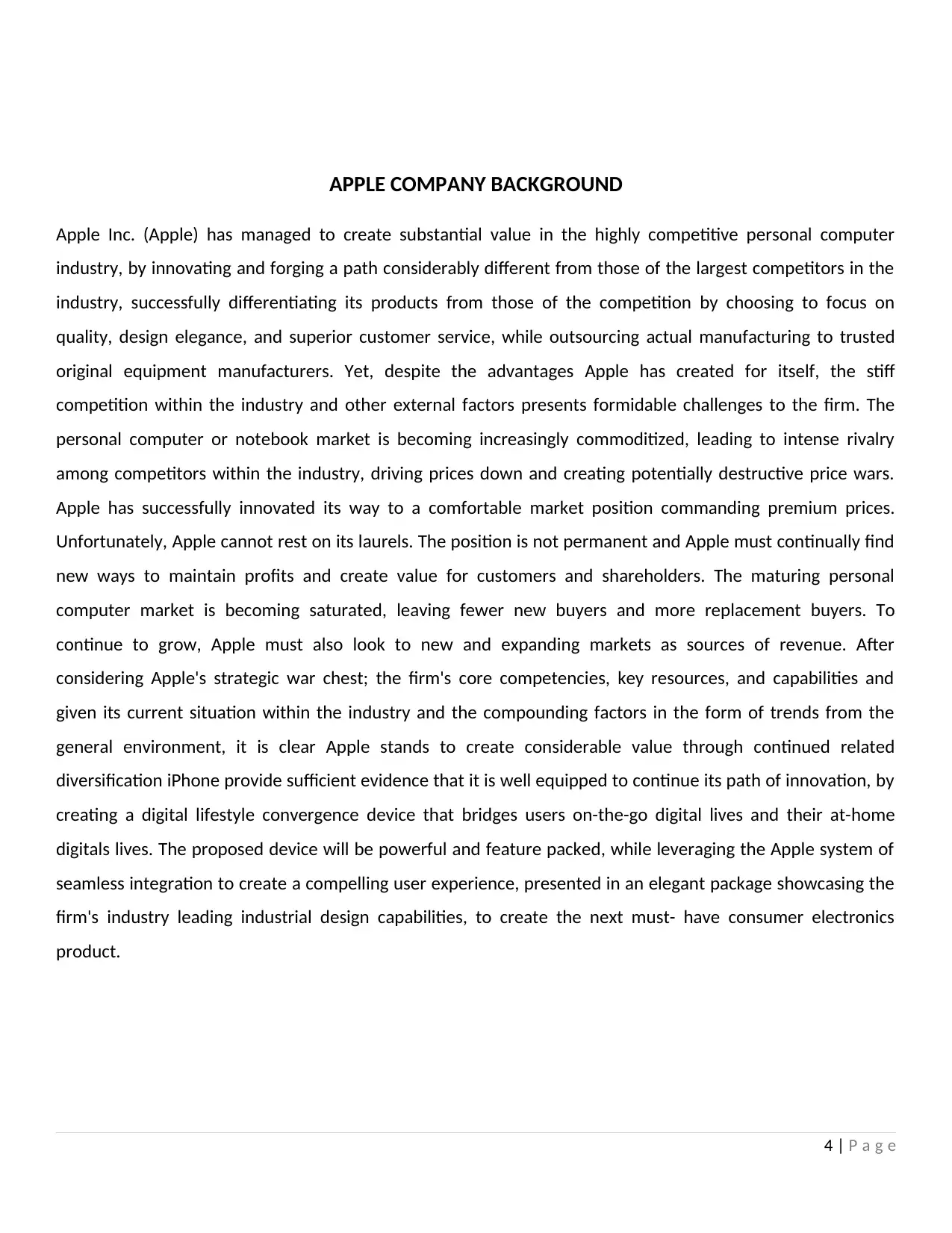
APPLE COMPANY BACKGROUND
Apple Inc. (Apple) has managed to create substantial value in the highly competitive personal computer
industry, by innovating and forging a path considerably different from those of the largest competitors in the
industry, successfully differentiating its products from those of the competition by choosing to focus on
quality, design elegance, and superior customer service, while outsourcing actual manufacturing to trusted
original equipment manufacturers. Yet, despite the advantages Apple has created for itself, the stiff
competition within the industry and other external factors presents formidable challenges to the firm. The
personal computer or notebook market is becoming increasingly commoditized, leading to intense rivalry
among competitors within the industry, driving prices down and creating potentially destructive price wars.
Apple has successfully innovated its way to a comfortable market position commanding premium prices.
Unfortunately, Apple cannot rest on its laurels. The position is not permanent and Apple must continually find
new ways to maintain profits and create value for customers and shareholders. The maturing personal
computer market is becoming saturated, leaving fewer new buyers and more replacement buyers. To
continue to grow, Apple must also look to new and expanding markets as sources of revenue. After
considering Apple's strategic war chest; the firm's core competencies, key resources, and capabilities and
given its current situation within the industry and the compounding factors in the form of trends from the
general environment, it is clear Apple stands to create considerable value through continued related
diversification iPhone provide sufficient evidence that it is well equipped to continue its path of innovation, by
creating a digital lifestyle convergence device that bridges users on-the-go digital lives and their at-home
digitals lives. The proposed device will be powerful and feature packed, while leveraging the Apple system of
seamless integration to create a compelling user experience, presented in an elegant package showcasing the
firm's industry leading industrial design capabilities, to create the next must- have consumer electronics
product.
4 | P a g e
Apple Inc. (Apple) has managed to create substantial value in the highly competitive personal computer
industry, by innovating and forging a path considerably different from those of the largest competitors in the
industry, successfully differentiating its products from those of the competition by choosing to focus on
quality, design elegance, and superior customer service, while outsourcing actual manufacturing to trusted
original equipment manufacturers. Yet, despite the advantages Apple has created for itself, the stiff
competition within the industry and other external factors presents formidable challenges to the firm. The
personal computer or notebook market is becoming increasingly commoditized, leading to intense rivalry
among competitors within the industry, driving prices down and creating potentially destructive price wars.
Apple has successfully innovated its way to a comfortable market position commanding premium prices.
Unfortunately, Apple cannot rest on its laurels. The position is not permanent and Apple must continually find
new ways to maintain profits and create value for customers and shareholders. The maturing personal
computer market is becoming saturated, leaving fewer new buyers and more replacement buyers. To
continue to grow, Apple must also look to new and expanding markets as sources of revenue. After
considering Apple's strategic war chest; the firm's core competencies, key resources, and capabilities and
given its current situation within the industry and the compounding factors in the form of trends from the
general environment, it is clear Apple stands to create considerable value through continued related
diversification iPhone provide sufficient evidence that it is well equipped to continue its path of innovation, by
creating a digital lifestyle convergence device that bridges users on-the-go digital lives and their at-home
digitals lives. The proposed device will be powerful and feature packed, while leveraging the Apple system of
seamless integration to create a compelling user experience, presented in an elegant package showcasing the
firm's industry leading industrial design capabilities, to create the next must- have consumer electronics
product.
4 | P a g e
Paraphrase This Document
Need a fresh take? Get an instant paraphrase of this document with our AI Paraphraser
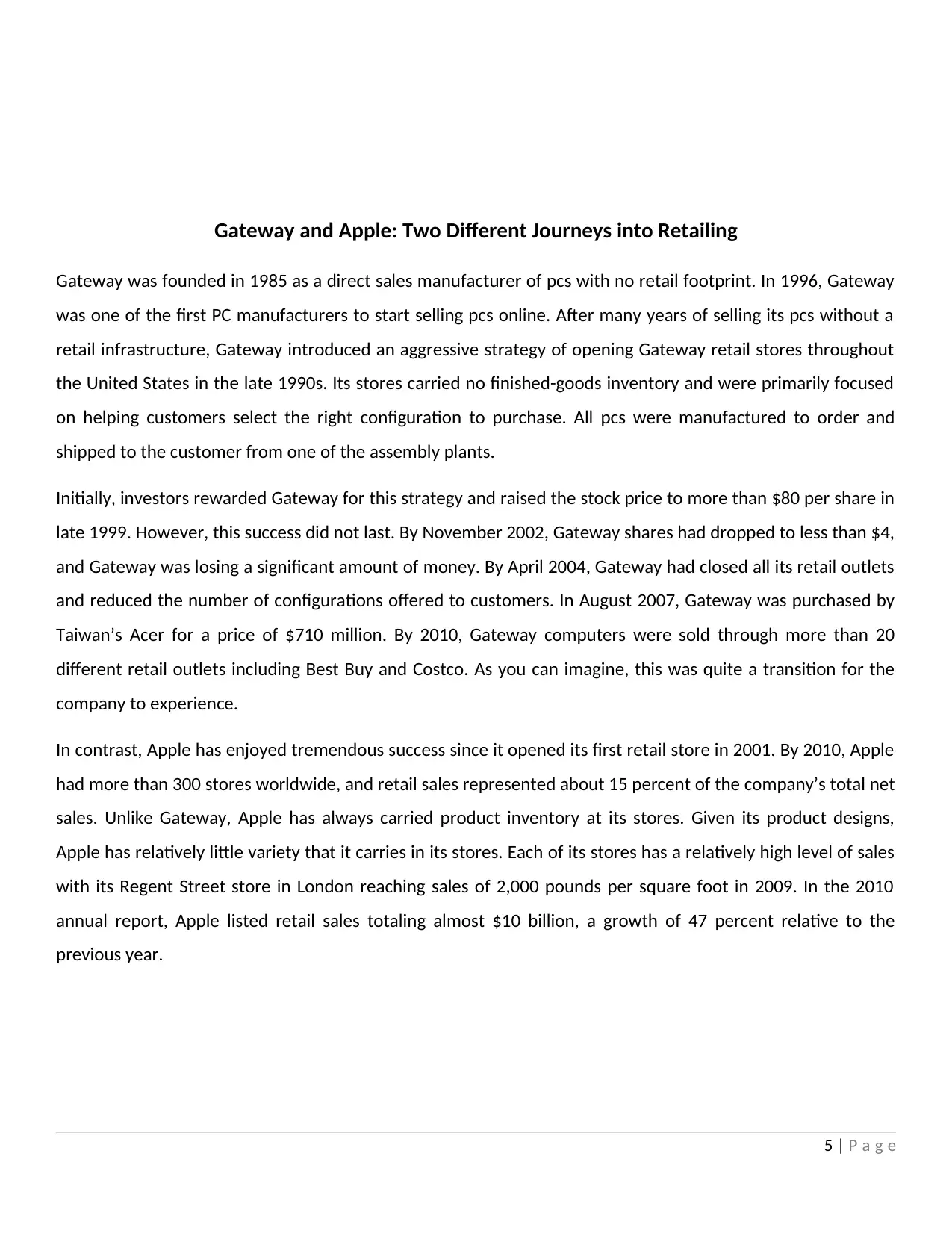
Gateway and Apple: Two Different Journeys into Retailing
Gateway was founded in 1985 as a direct sales manufacturer of pcs with no retail footprint. In 1996, Gateway
was one of the first PC manufacturers to start selling pcs online. After many years of selling its pcs without a
retail infrastructure, Gateway introduced an aggressive strategy of opening Gateway retail stores throughout
the United States in the late 1990s. Its stores carried no finished-goods inventory and were primarily focused
on helping customers select the right configuration to purchase. All pcs were manufactured to order and
shipped to the customer from one of the assembly plants.
Initially, investors rewarded Gateway for this strategy and raised the stock price to more than $80 per share in
late 1999. However, this success did not last. By November 2002, Gateway shares had dropped to less than $4,
and Gateway was losing a significant amount of money. By April 2004, Gateway had closed all its retail outlets
and reduced the number of configurations offered to customers. In August 2007, Gateway was purchased by
Taiwan’s Acer for a price of $710 million. By 2010, Gateway computers were sold through more than 20
different retail outlets including Best Buy and Costco. As you can imagine, this was quite a transition for the
company to experience.
In contrast, Apple has enjoyed tremendous success since it opened its first retail store in 2001. By 2010, Apple
had more than 300 stores worldwide, and retail sales represented about 15 percent of the company’s total net
sales. Unlike Gateway, Apple has always carried product inventory at its stores. Given its product designs,
Apple has relatively little variety that it carries in its stores. Each of its stores has a relatively high level of sales
with its Regent Street store in London reaching sales of 2,000 pounds per square foot in 2009. In the 2010
annual report, Apple listed retail sales totaling almost $10 billion, a growth of 47 percent relative to the
previous year.
5 | P a g e
Gateway was founded in 1985 as a direct sales manufacturer of pcs with no retail footprint. In 1996, Gateway
was one of the first PC manufacturers to start selling pcs online. After many years of selling its pcs without a
retail infrastructure, Gateway introduced an aggressive strategy of opening Gateway retail stores throughout
the United States in the late 1990s. Its stores carried no finished-goods inventory and were primarily focused
on helping customers select the right configuration to purchase. All pcs were manufactured to order and
shipped to the customer from one of the assembly plants.
Initially, investors rewarded Gateway for this strategy and raised the stock price to more than $80 per share in
late 1999. However, this success did not last. By November 2002, Gateway shares had dropped to less than $4,
and Gateway was losing a significant amount of money. By April 2004, Gateway had closed all its retail outlets
and reduced the number of configurations offered to customers. In August 2007, Gateway was purchased by
Taiwan’s Acer for a price of $710 million. By 2010, Gateway computers were sold through more than 20
different retail outlets including Best Buy and Costco. As you can imagine, this was quite a transition for the
company to experience.
In contrast, Apple has enjoyed tremendous success since it opened its first retail store in 2001. By 2010, Apple
had more than 300 stores worldwide, and retail sales represented about 15 percent of the company’s total net
sales. Unlike Gateway, Apple has always carried product inventory at its stores. Given its product designs,
Apple has relatively little variety that it carries in its stores. Each of its stores has a relatively high level of sales
with its Regent Street store in London reaching sales of 2,000 pounds per square foot in 2009. In the 2010
annual report, Apple listed retail sales totaling almost $10 billion, a growth of 47 percent relative to the
previous year.
5 | P a g e
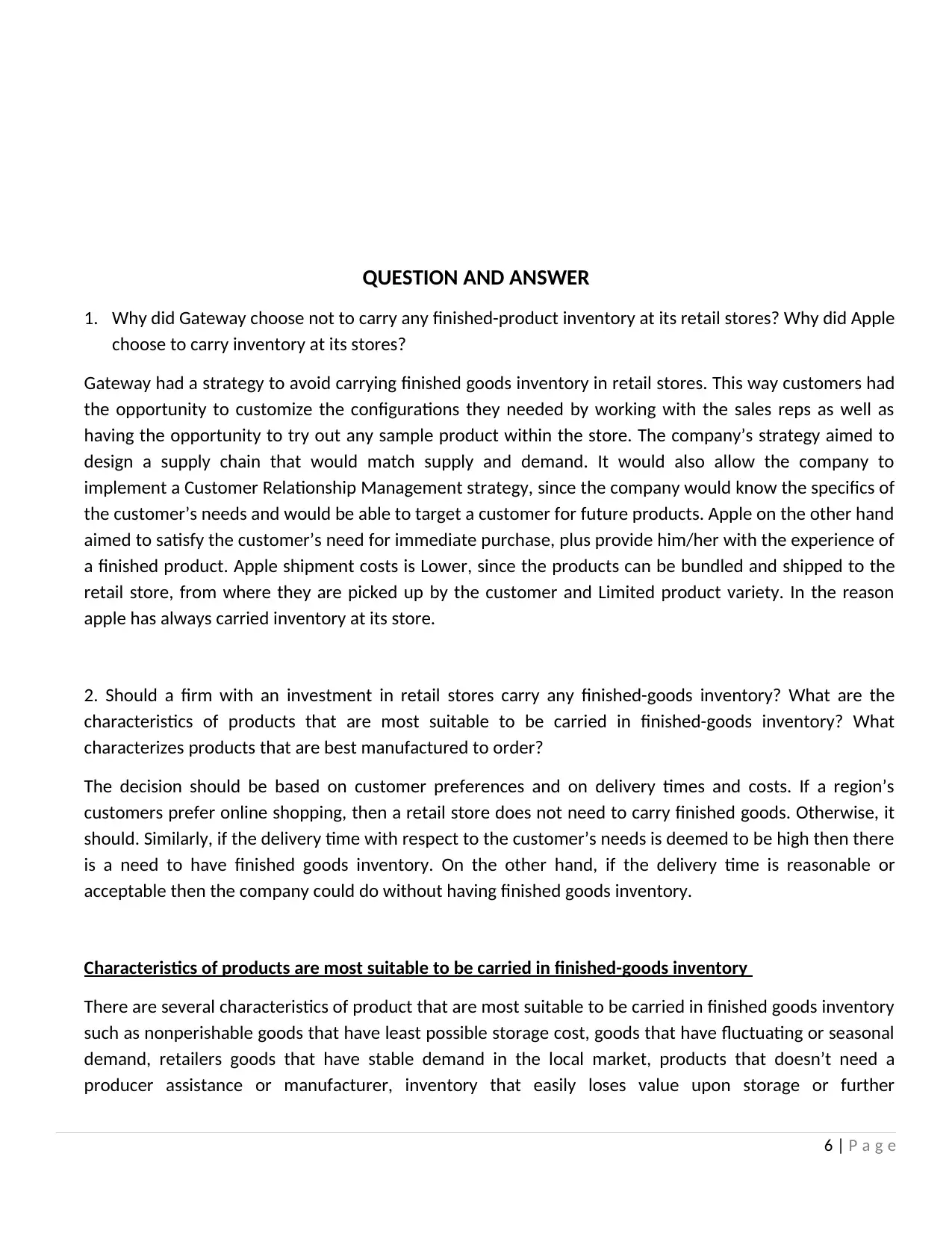
QUESTION AND ANSWER
1. Why did Gateway choose not to carry any finished-product inventory at its retail stores? Why did Apple
choose to carry inventory at its stores?
Gateway had a strategy to avoid carrying finished goods inventory in retail stores. This way customers had
the opportunity to customize the configurations they needed by working with the sales reps as well as
having the opportunity to try out any sample product within the store. The company’s strategy aimed to
design a supply chain that would match supply and demand. It would also allow the company to
implement a Customer Relationship Management strategy, since the company would know the specifics of
the customer’s needs and would be able to target a customer for future products. Apple on the other hand
aimed to satisfy the customer’s need for immediate purchase, plus provide him/her with the experience of
a finished product. Apple shipment costs is Lower, since the products can be bundled and shipped to the
retail store, from where they are picked up by the customer and Limited product variety. In the reason
apple has always carried inventory at its store.
2. Should a firm with an investment in retail stores carry any finished-goods inventory? What are the
characteristics of products that are most suitable to be carried in finished-goods inventory? What
characterizes products that are best manufactured to order?
The decision should be based on customer preferences and on delivery times and costs. If a region’s
customers prefer online shopping, then a retail store does not need to carry finished goods. Otherwise, it
should. Similarly, if the delivery time with respect to the customer’s needs is deemed to be high then there
is a need to have finished goods inventory. On the other hand, if the delivery time is reasonable or
acceptable then the company could do without having finished goods inventory.
Characteristics of products are most suitable to be carried in finished-goods inventory
There are several characteristics of product that are most suitable to be carried in finished goods inventory
such as nonperishable goods that have least possible storage cost, goods that have fluctuating or seasonal
demand, retailers goods that have stable demand in the local market, products that doesn’t need a
producer assistance or manufacturer, inventory that easily loses value upon storage or further
6 | P a g e
1. Why did Gateway choose not to carry any finished-product inventory at its retail stores? Why did Apple
choose to carry inventory at its stores?
Gateway had a strategy to avoid carrying finished goods inventory in retail stores. This way customers had
the opportunity to customize the configurations they needed by working with the sales reps as well as
having the opportunity to try out any sample product within the store. The company’s strategy aimed to
design a supply chain that would match supply and demand. It would also allow the company to
implement a Customer Relationship Management strategy, since the company would know the specifics of
the customer’s needs and would be able to target a customer for future products. Apple on the other hand
aimed to satisfy the customer’s need for immediate purchase, plus provide him/her with the experience of
a finished product. Apple shipment costs is Lower, since the products can be bundled and shipped to the
retail store, from where they are picked up by the customer and Limited product variety. In the reason
apple has always carried inventory at its store.
2. Should a firm with an investment in retail stores carry any finished-goods inventory? What are the
characteristics of products that are most suitable to be carried in finished-goods inventory? What
characterizes products that are best manufactured to order?
The decision should be based on customer preferences and on delivery times and costs. If a region’s
customers prefer online shopping, then a retail store does not need to carry finished goods. Otherwise, it
should. Similarly, if the delivery time with respect to the customer’s needs is deemed to be high then there
is a need to have finished goods inventory. On the other hand, if the delivery time is reasonable or
acceptable then the company could do without having finished goods inventory.
Characteristics of products are most suitable to be carried in finished-goods inventory
There are several characteristics of product that are most suitable to be carried in finished goods inventory
such as nonperishable goods that have least possible storage cost, goods that have fluctuating or seasonal
demand, retailers goods that have stable demand in the local market, products that doesn’t need a
producer assistance or manufacturer, inventory that easily loses value upon storage or further
6 | P a g e
⊘ This is a preview!⊘
Do you want full access?
Subscribe today to unlock all pages.

Trusted by 1+ million students worldwide
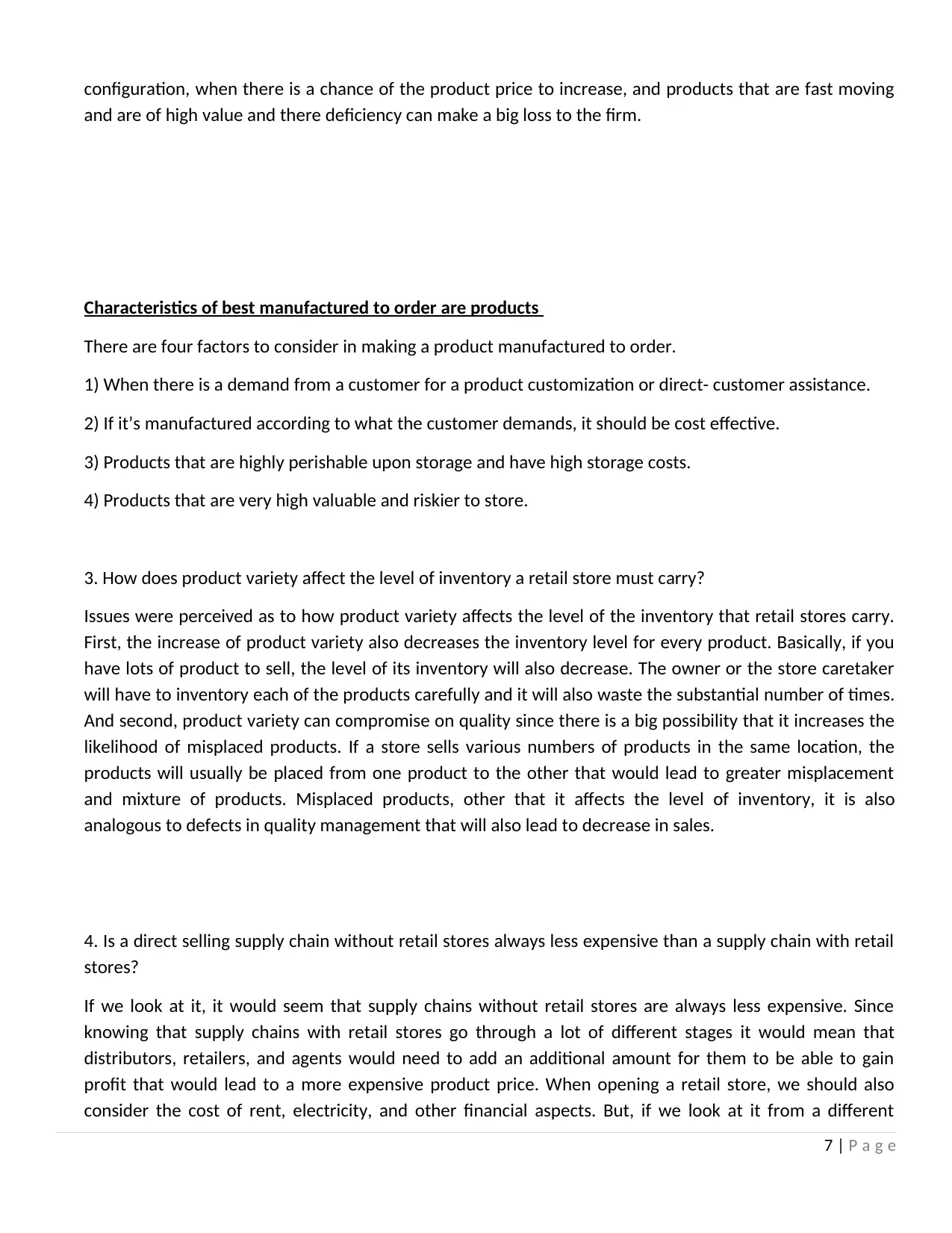
configuration, when there is a chance of the product price to increase, and products that are fast moving
and are of high value and there deficiency can make a big loss to the firm.
Characteristics of best manufactured to order are products
There are four factors to consider in making a product manufactured to order.
1) When there is a demand from a customer for a product customization or direct- customer assistance.
2) If it’s manufactured according to what the customer demands, it should be cost effective.
3) Products that are highly perishable upon storage and have high storage costs.
4) Products that are very high valuable and riskier to store.
3. How does product variety affect the level of inventory a retail store must carry?
Issues were perceived as to how product variety affects the level of the inventory that retail stores carry.
First, the increase of product variety also decreases the inventory level for every product. Basically, if you
have lots of product to sell, the level of its inventory will also decrease. The owner or the store caretaker
will have to inventory each of the products carefully and it will also waste the substantial number of times.
And second, product variety can compromise on quality since there is a big possibility that it increases the
likelihood of misplaced products. If a store sells various numbers of products in the same location, the
products will usually be placed from one product to the other that would lead to greater misplacement
and mixture of products. Misplaced products, other that it affects the level of inventory, it is also
analogous to defects in quality management that will also lead to decrease in sales.
4. Is a direct selling supply chain without retail stores always less expensive than a supply chain with retail
stores?
If we look at it, it would seem that supply chains without retail stores are always less expensive. Since
knowing that supply chains with retail stores go through a lot of different stages it would mean that
distributors, retailers, and agents would need to add an additional amount for them to be able to gain
profit that would lead to a more expensive product price. When opening a retail store, we should also
consider the cost of rent, electricity, and other financial aspects. But, if we look at it from a different
7 | P a g e
and are of high value and there deficiency can make a big loss to the firm.
Characteristics of best manufactured to order are products
There are four factors to consider in making a product manufactured to order.
1) When there is a demand from a customer for a product customization or direct- customer assistance.
2) If it’s manufactured according to what the customer demands, it should be cost effective.
3) Products that are highly perishable upon storage and have high storage costs.
4) Products that are very high valuable and riskier to store.
3. How does product variety affect the level of inventory a retail store must carry?
Issues were perceived as to how product variety affects the level of the inventory that retail stores carry.
First, the increase of product variety also decreases the inventory level for every product. Basically, if you
have lots of product to sell, the level of its inventory will also decrease. The owner or the store caretaker
will have to inventory each of the products carefully and it will also waste the substantial number of times.
And second, product variety can compromise on quality since there is a big possibility that it increases the
likelihood of misplaced products. If a store sells various numbers of products in the same location, the
products will usually be placed from one product to the other that would lead to greater misplacement
and mixture of products. Misplaced products, other that it affects the level of inventory, it is also
analogous to defects in quality management that will also lead to decrease in sales.
4. Is a direct selling supply chain without retail stores always less expensive than a supply chain with retail
stores?
If we look at it, it would seem that supply chains without retail stores are always less expensive. Since
knowing that supply chains with retail stores go through a lot of different stages it would mean that
distributors, retailers, and agents would need to add an additional amount for them to be able to gain
profit that would lead to a more expensive product price. When opening a retail store, we should also
consider the cost of rent, electricity, and other financial aspects. But, if we look at it from a different
7 | P a g e
Paraphrase This Document
Need a fresh take? Get an instant paraphrase of this document with our AI Paraphraser
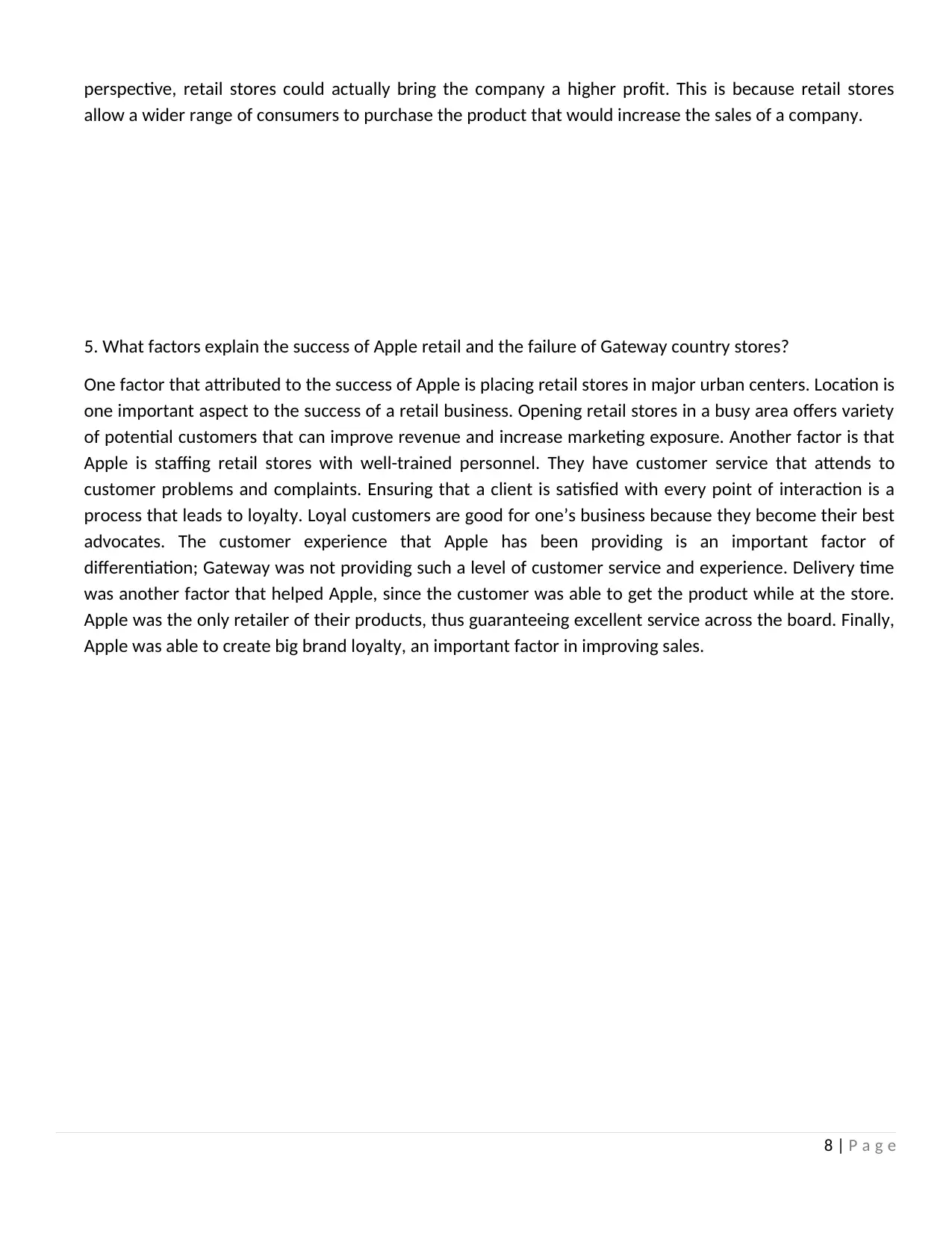
perspective, retail stores could actually bring the company a higher profit. This is because retail stores
allow a wider range of consumers to purchase the product that would increase the sales of a company.
5. What factors explain the success of Apple retail and the failure of Gateway country stores?
One factor that attributed to the success of Apple is placing retail stores in major urban centers. Location is
one important aspect to the success of a retail business. Opening retail stores in a busy area offers variety
of potential customers that can improve revenue and increase marketing exposure. Another factor is that
Apple is staffing retail stores with well-trained personnel. They have customer service that attends to
customer problems and complaints. Ensuring that a client is satisfied with every point of interaction is a
process that leads to loyalty. Loyal customers are good for one’s business because they become their best
advocates. The customer experience that Apple has been providing is an important factor of
differentiation; Gateway was not providing such a level of customer service and experience. Delivery time
was another factor that helped Apple, since the customer was able to get the product while at the store.
Apple was the only retailer of their products, thus guaranteeing excellent service across the board. Finally,
Apple was able to create big brand loyalty, an important factor in improving sales.
8 | P a g e
allow a wider range of consumers to purchase the product that would increase the sales of a company.
5. What factors explain the success of Apple retail and the failure of Gateway country stores?
One factor that attributed to the success of Apple is placing retail stores in major urban centers. Location is
one important aspect to the success of a retail business. Opening retail stores in a busy area offers variety
of potential customers that can improve revenue and increase marketing exposure. Another factor is that
Apple is staffing retail stores with well-trained personnel. They have customer service that attends to
customer problems and complaints. Ensuring that a client is satisfied with every point of interaction is a
process that leads to loyalty. Loyal customers are good for one’s business because they become their best
advocates. The customer experience that Apple has been providing is an important factor of
differentiation; Gateway was not providing such a level of customer service and experience. Delivery time
was another factor that helped Apple, since the customer was able to get the product while at the store.
Apple was the only retailer of their products, thus guaranteeing excellent service across the board. Finally,
Apple was able to create big brand loyalty, an important factor in improving sales.
8 | P a g e
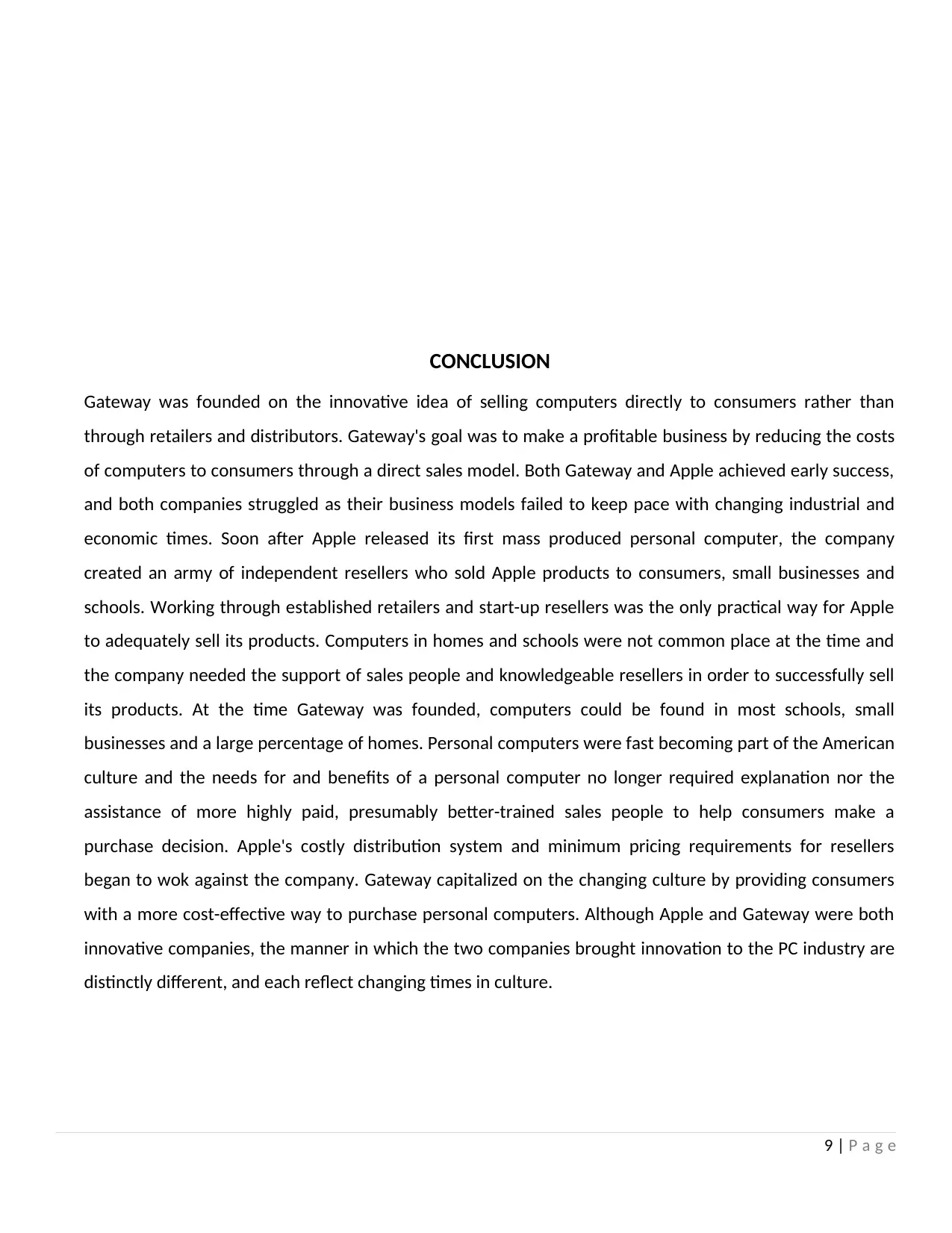
CONCLUSION
Gateway was founded on the innovative idea of selling computers directly to consumers rather than
through retailers and distributors. Gateway's goal was to make a profitable business by reducing the costs
of computers to consumers through a direct sales model. Both Gateway and Apple achieved early success,
and both companies struggled as their business models failed to keep pace with changing industrial and
economic times. Soon after Apple released its first mass produced personal computer, the company
created an army of independent resellers who sold Apple products to consumers, small businesses and
schools. Working through established retailers and start-up resellers was the only practical way for Apple
to adequately sell its products. Computers in homes and schools were not common place at the time and
the company needed the support of sales people and knowledgeable resellers in order to successfully sell
its products. At the time Gateway was founded, computers could be found in most schools, small
businesses and a large percentage of homes. Personal computers were fast becoming part of the American
culture and the needs for and benefits of a personal computer no longer required explanation nor the
assistance of more highly paid, presumably better-trained sales people to help consumers make a
purchase decision. Apple's costly distribution system and minimum pricing requirements for resellers
began to wok against the company. Gateway capitalized on the changing culture by providing consumers
with a more cost-effective way to purchase personal computers. Although Apple and Gateway were both
innovative companies, the manner in which the two companies brought innovation to the PC industry are
distinctly different, and each reflect changing times in culture.
9 | P a g e
Gateway was founded on the innovative idea of selling computers directly to consumers rather than
through retailers and distributors. Gateway's goal was to make a profitable business by reducing the costs
of computers to consumers through a direct sales model. Both Gateway and Apple achieved early success,
and both companies struggled as their business models failed to keep pace with changing industrial and
economic times. Soon after Apple released its first mass produced personal computer, the company
created an army of independent resellers who sold Apple products to consumers, small businesses and
schools. Working through established retailers and start-up resellers was the only practical way for Apple
to adequately sell its products. Computers in homes and schools were not common place at the time and
the company needed the support of sales people and knowledgeable resellers in order to successfully sell
its products. At the time Gateway was founded, computers could be found in most schools, small
businesses and a large percentage of homes. Personal computers were fast becoming part of the American
culture and the needs for and benefits of a personal computer no longer required explanation nor the
assistance of more highly paid, presumably better-trained sales people to help consumers make a
purchase decision. Apple's costly distribution system and minimum pricing requirements for resellers
began to wok against the company. Gateway capitalized on the changing culture by providing consumers
with a more cost-effective way to purchase personal computers. Although Apple and Gateway were both
innovative companies, the manner in which the two companies brought innovation to the PC industry are
distinctly different, and each reflect changing times in culture.
9 | P a g e
⊘ This is a preview!⊘
Do you want full access?
Subscribe today to unlock all pages.

Trusted by 1+ million students worldwide
1 out of 9
Your All-in-One AI-Powered Toolkit for Academic Success.
+13062052269
info@desklib.com
Available 24*7 on WhatsApp / Email
![[object Object]](/_next/static/media/star-bottom.7253800d.svg)
Unlock your academic potential
Copyright © 2020–2025 A2Z Services. All Rights Reserved. Developed and managed by ZUCOL.